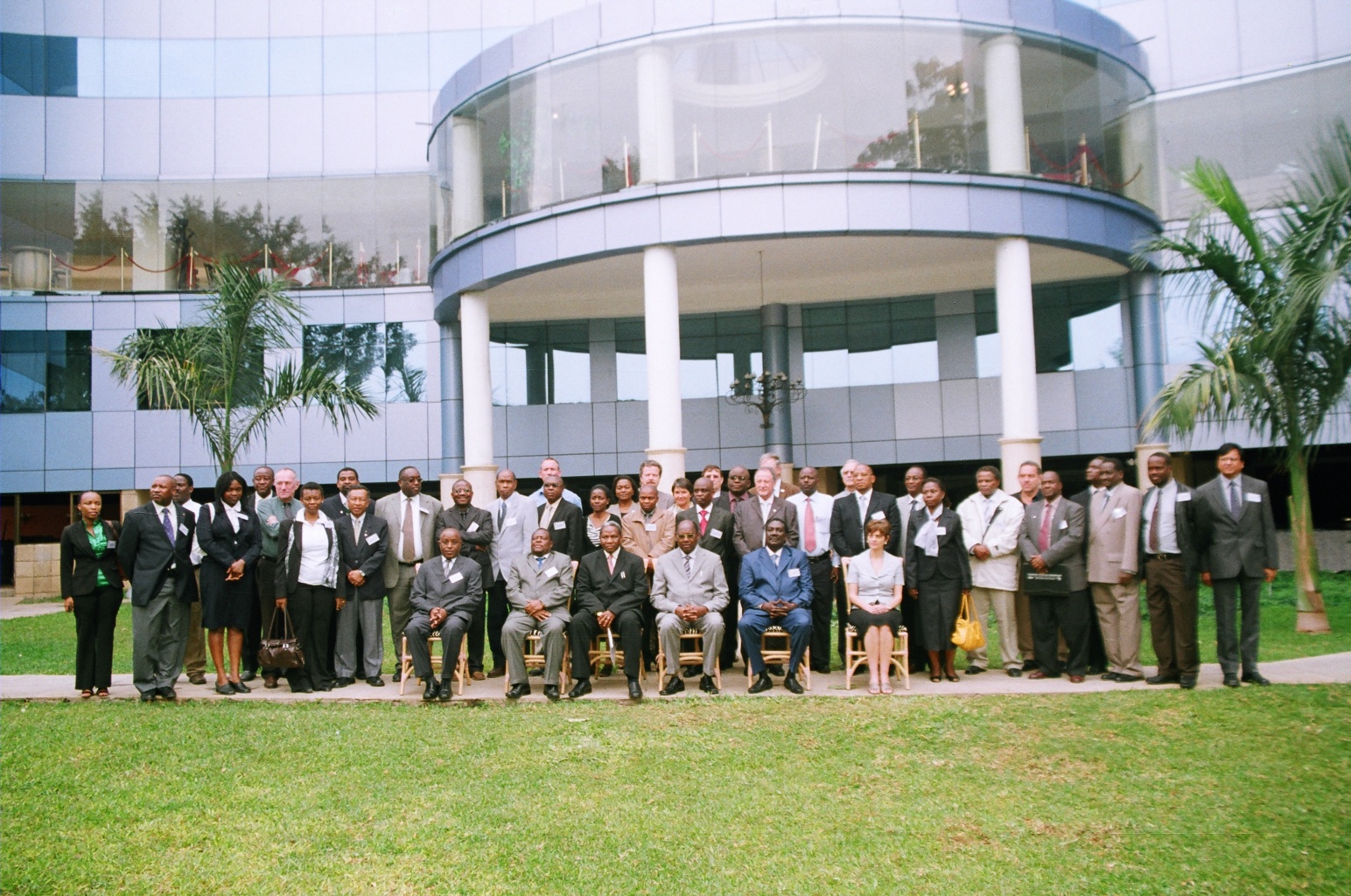
Opening statements by the Minister of Livestock Development and Fisheries. Picture (c) P. Bastiaensen (oie) 2009.
Recommendation n° 1 : Veterinary Statutory Bodies
Considering :
1. The OIE standards on the quality of veterinary services, in particular the provisions of chapter 3, section 2.12 of the Terrestrial Animal Health Code on veterinary statutory bodies (VSB) ;
2. The current and foreseeable demand for veterinarians and veterinary para-professionals in the SADC region;
3. The disparities between registration requirements and quality-assurance of veterinarians and veterinary para-professionals and applicable legislation for the constitution of veterinary statutory bodies (VSB) in the various countries, as well as the current absence of formal VSB’s in others;
4. The increased challenges faced by the veterinary profession by new societal demands in the field of food security, food safety, public health, animal welfare and the environment, by increased regional integration and the consecutive mobility of veterinary professionals and their services;
5. The challenges in the delivery of primary animal health services to smallholders/ small scale/communal farmers in rural areas;
6. The insufficient development of public – private veterinary partnerships in some countries in the overall control and prevention of OIE listed diseases;
7. The need to enable better horizontal cooperation and mutual recognition between VSB’s in the SADC region;
8. The upcoming OIE Global Conference on Evolving Veterinary Education for a Safer World, to be held in Paris in Oct. 2009;
the participants recommend :
1. That VSB’s in the SADC region should work towards improved coordination and communication in the short term (1 year) sharing of information, and harmonization of their registration requirements and operational procedures in the mid term (3 years);
2. That a working group be formed to evaluate the registration requirements and operational procedures to reach consensus on the alignment thereof and in particular on the minimum standards of training;
3. That VSB’s endeavour to work towards the establishment of a Southern African Forum of VSB’s, to harmonise the respective objectives and seek solution for the challenges of the VSB’s within the region, and
4. That the OIE consider facilitating a platform to enable more frequent electronic or face-to-face coordination meetings between registrars and/or chairpersons of VSB’s, and, during a very short transitional period, chairpersons of veterinary associations, where VSB’s do not exist;
5. That the VSB’s of the region establish a list of faculties that are subjected to external audit from the region whose graduates qualify for unconditional registration without writing a council exam (where applicable), the criteria of which are accepted throughout the region;
6. That the OIE consider extending the twinning programme to VSB’s to enter into bi-lateral agreements in order to achieve agreed requirements;
7. That the establishment (where applicable), structure and operation (SOP’s) of VSB’s be developed along the lines of the OIE standards, as stipulated in the Terrestrial Animal Health Code, chapter 3, section 2.12, including the involvement of relevant stakeholders;
8. That national veterinary authorities of countries that have done a PVS evaluation, be urged to address the findings of the evaluation, and where appropriate, are invited to apply for a post PVS OIE gap – analysis to address shortcomings, or support on veterinary legislation review to address outdated legislation or seek conformity with OIE standards.
Recommendation n° 2 : Veterinary Education
Considering :
1. The importance and need for highly qualified veterinarians and veterinary paraprofessionals in SADC, as well as the fact that the World Organisation for Animal Health (OIE) considers the issue of initial and continuous veterinary education as part of its commitment to encouraging its Members to strengthen the activities of their National Veterinary Services;
2. The emergence of new diseases, the increase in new pathogens, the threat of transboundary animal diseases, the impact of environmental changes as well as the new societal demands in the field of food security, food safety, public health and animal welfare;
3. The need to train veterinarians and veterinary paraprofessionals to meet this new expectations at a global, regional and national levels;
4. The implementation of the new global concept “One World-One Health’ which brings together animal health, public health and environmental health;
5. The fact that Africa cannot isolate itself from global trends and must take into consideration global animal and human health issues;
6. The need, on the other hand, for veterinarians and veterinary paraprofessionals to be locally relevant to professional requirements, societal needs, political expectations and environmental changes in the SADC region;
7. The existence of both similarities and wide disparities in veterinary training and veterinary training capacities between veterinary faculties in the region and from different parts of the world;
8. The fact that current regulatory systems in SADC Member States often hinder mobility of veterinarians and veterinary paraprofessionals, and the need for mutual recognition of veterinary and veterinary paraprofessionals training within the region;
9. The technological and pedagogic advances in veterinary education delivery;
10. The need for additional knowledge and skills for veterinarians such as in communication, leadership and interpersonal relationship;
11. The need for sharing human resources and available infrastructures for initial and continuous education of veterinarians and paraprofessionals in the region, and the high cost of veterinary education;
12. The existing willingness of veterinary faculties in SADC to work with all interested parties including OIE and respective National Veterinary Services to develop innovative teaching and learning methods in veterinary education;
the participants recommend :
1. That the existing Deans meeting (under the NUFU programme) be maintained and expanded to a Veterinary Education Forum (VEF) and to include other veterinary training institutes and countries in SADC through:
a) The development of an electronic/ telematic platform for e-networking
b) An annual meeting of Deans but also to include representatives of other countries in SADC with a particular interest in veterinary education;
2. That curricular reviews currently being undertaken within the veterinary schools in SADC should, through consideration by the Veterinary Education Forum :
a) Identify areas of potential harmonisation within SADC.
b) Consider a core-elective approach with the development of Day-One competencies relevant to SADC.
c) Consider types of elective programmes required within SADC.
d) Consider additional knowledge and skills, such as in communication, leadership and interpersonal relationship required for veterinarians in SADC.
e) Consider technological and pedagogic advances to be applied in veterinary education delivery within SADC.
f) Consider ways to harmonise admission and assessment policies applied within veterinary schools in SADC.
g) Consider national, regional and global human and animal health issues that impact on the training of veterinarians within SADC;
3. Collaboration and partnerships through Memoranda of Understanding (MoUs) between the veterinary schools should be developed and where possible “Twinning programmes” established within SADC as well as with partners in the developed countries to :
a) Identify areas of collaboration in undergraduate curricular development and harmonization.
b) Assist where possible in undergraduate student training.
c) Create opportunities for academic and research staff exchange.
d) Identify and develop opportunities for collaboration and partnerships in post graduate training and research.
e) Identify and develop centers of special veterinary competence within SADC for use in elective programmes.
f) Create opportunities for veterinary specialist training.
g) Collaborate in the delivery of continuing education programmes in SADC.
h) Support the development and responsibilities of the OIE Collaborating Centre for Training in Integrated Livestock and Wildlife Health and Management.
i) Identify additional areas that should be developed and recognized as OIE Collaborating Centers.
j) Considering ways in which collectively the SADC Region can promote veterinary education as public good.
k) Consider ways in which veterinary schools can become more involved in poverty alleviation (income generation) through their undergraduate, post graduate, community engagement and research programmes;
4. That the OIE facilitate a workshop to consider the needs and requirements for veterinary paraprofessional training within SADC.
5. That these recommendations be promoted during the OIE Global Conference on Veterinary Education in October 2009, in Paris, and that the recommendations adopted by this global conference be taken into account by SADC countries and Veterinary Faculties.
All pictures (c) P. Bastiaensen (oie) 2009



